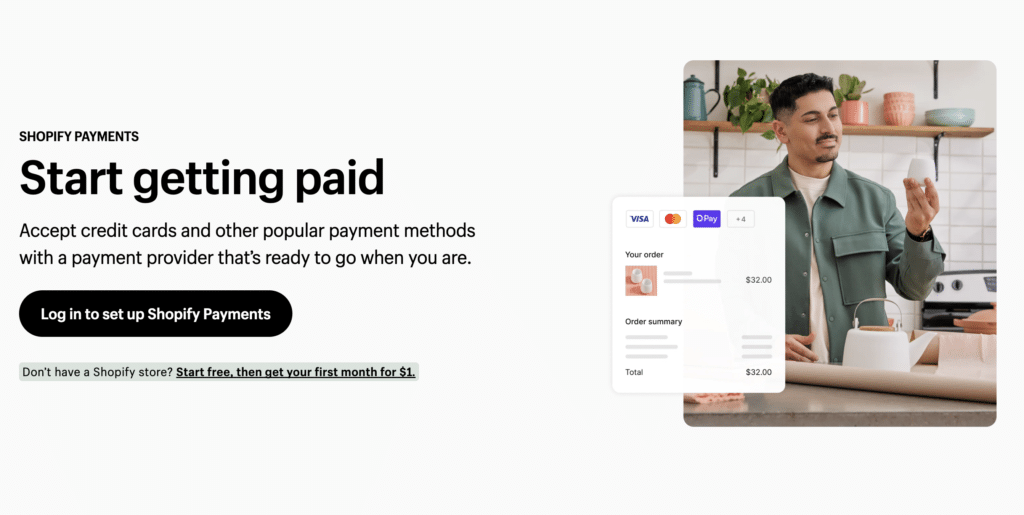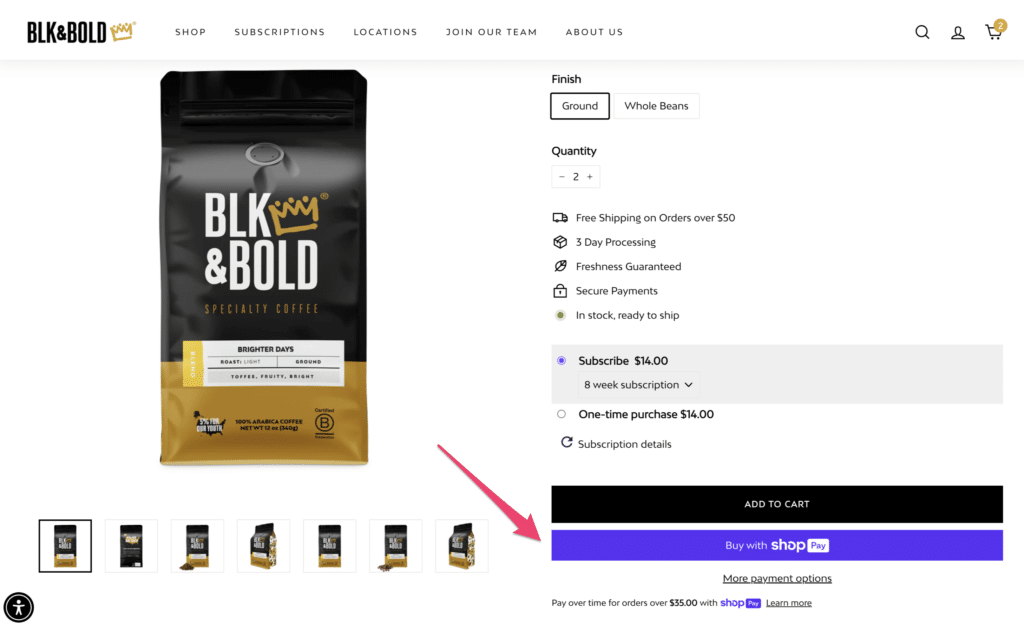More than 4.61 million online stores worldwide are powered by Shopify—making it one of the largest ecommerce platforms in existence. It supports over 100+ integrations with payment providers, giving merchants plenty of third-party options to choose from.
But Shopify also has two of its own payment solutions: Shop Pay and Shopify Payments.
Due to the similarity of these names and the fact that they’re both coming from one provider can be confusing. But simply put, Shop Pay and Shopify Payments are not the same thing.
Read on for a more in-depth clarification between these two solutions—including key differences, pros, cons, examples, and use cases for each one.
What is Shop Pay?
Shop Pay is Shopify’s rapid checkout feature, which was designed to help streamline the purchase process for consumers. Shoppers have the ability to save their payment information and shipping details securely, so they can complete future purchases with just a few clicks.
Shop Pay is not a payment processor but rather an accelerated checkout feature that works alongside existing payment gateways that are already in place.
Any business that’s using Shopify automatically gets Shop Pay without any additional fees. However, Buy Now Pay Later (BNPL) purchases via Shop Pay cost merchants 5.9% + $0.30 per transaction. This is more than double the average credit card processing fee, but it’s an optional feature that can be turned off.
What is Shopify Payments?
Shopify Payments is a native payment processing solution that’s built directly into Shopify’s ecommerce platform. It allows merchants to accept payments from online shoppers without having to set up a third-party payment provider or a merchant account.
This is a fully integrated payment system that includes payment acceptance from all major credit cards, digital wallets, and more. It also includes features for fraud analysis, financial reporting, and other perks that we typically see from integrated providers.
While Shopify Payments is the default payment option for new Shopify websites, it’s only available in 23 countries. Fees start at 2.9% + $0.30 per transaction for online payments with US merchants.
What’s the Difference Between Shop Pay and Shopify Payments?
Shop Pay is a customer-focused checkout button, whereas Shopify Payments is a processing solution. When enabled, the Shop Pay button gives shoppers the ability to pay using stored credentials for a faster checkout. But Shop Pay on its own doesn’t actually process payments and still requires an online payment gateway to work.
Shopify Payments could be that payment gateway, but merchants can still enable Shop Pay if they’re using a third-party provider.
Shop Pay and Shopify Payments are not required to use Shopify. You could use one, both, or neither—it’s totally up to you.
Key Differences
- Shopify Payments is a gateway: It processes transactions directly, allowing merchants to accept payments without going through a third-party processor.
- Shop Pay works with multiple gateways: Shop Pay works with other third-party gateways and will soon be available for non-Shopify merchants selling on social media.
- Shopify Payments handles the entire payment process: As an integrated payments solution, Shopify Payments handles everything from the initial customer-facing transaction through the deposit into the business bank account.
- Shop Pay offers installment options: Customers can split purchases into payment installments over time via Shop Pay’s BNPL feature.
- Shopify Payments is limited to Shopify’s platform: It can only be used by merchants on Shopify, unlike other gateways that work across various ecommerce platforms.
- Shop Pay is more customer-focused: It prioritizes user experience and conversion optimization by offering a one-click checkout for returning customers with stored payment details.
Pros and Cons Compared
Shop Pay and Shopify Payments both offer unique benefits to merchants, but they also have some drawbacks and potential limitations. Understanding these can help you decide if either or both are right for your business.
Shop Pay Pros
- Speeds up the checkout process
- Helps reduce cart abandonment rates
- Works across all Shopify stores
- No additional costs for basic functionality
Shop Pay Cons
- Requires customers to create an account and save their information
- Limited to Shopify’s platform (not available on other ecommerce sites)
- High fees for BNPL transactions
- Still requires a payment gateway to work
Shopify Payments Pros
- Fully integrated within Shopify
- Eliminates the need for third-party payment processors
- You don’t need a merchant account for Shopify Payments
- Extra tools like financial reporting and fraud analysis are included
Shopify Payments Cons
- Only available in 23 countries
- Tied exclusively to Shopify’s platform
- Higher fees compared to other payment processors
- Can be subject to holds or reserves on merchant funds
Common Use Cases For Shop Pay and Shopify Payments
Still unsure if either of these tools is right for you? Here are some common scenarios of when businesses typically use Shop Pay, Shopify Payments, or both.
When to Use Shop Pay
- You have lots of repeat ecommerce customers
- You want to offer BNPL installment options and don’t care about the high cost
- Your online store gets mostly mobile traffic
- You have low conversion rates and need a way to reduce cart abandonment
When to Use Shopify Payments
- You’re just getting started on Shopify and aren’t expecting many sales
- You’re looking for a fast and simple way to get start accept payments
- You don’t want to apply for a merchant account
- You don’t mind paying higher-than-average fees to accept payments
When to Use Both
- You want your customers to have a wide range of payment options
- You’re already using Shopify Payments and want to add the Shop Pay button
- You value simplicity over cost savings
- You don’t want to connect with third-party gateways
Shop Pay in Action: Example From a Real Ecommerce Website
It’s often easier to understand how something works when you see it being used in real life. So let’s look at a Shopify store that has the Shop Pay button enabled:
Remember, this is a customer-focused feature.
So from the product page, I have the option to click “Buy with Shop Pay” instead of adding the item to my cart. If I’m already logged into my Shop Pay account with my credentials stored, I’ll be able to complete this purchase with just two clicks.
On the flip side, if I don’t have Shop Pay, there are extra steps added to the checkout process.
I’d have to add the item to my cart, then manually fill out all of my shipping information, credit card info, and more.
But the Shop Pay feature bypasses all of that, and lets the customer check out in a matter of seconds compared to minutes (assuming they’re previously set up a Shop Pay account).
Additional Learning: Your FAQs Answered
Is Shop Pay Owned by Shopify?
Yes, Shop Pay is owned by Shopify. It was developed by Shopify and officially launched in 2017 as an internal feature within Shopify’s ecosystem.
Is Shop Pay and Shopify the Same Thing?
No, Shop Pay and Shopify are not the same thing. Shopify is an ecommerce platform, while Shop Pay is a specific checkout feature offered to merchants using Shopify.
How Much Does Shop Pay Cost?
Shop Pay itself is free for merchants using Shopify. However, if you choose to offer Shop Pay Installments (its BNPL option), there’s a 5.9% + $0.30 per transaction fee for those payments. Otherwise, you’ll just be charged for your normal payment processing rates (unless your provider adds extra fees for this integration).




